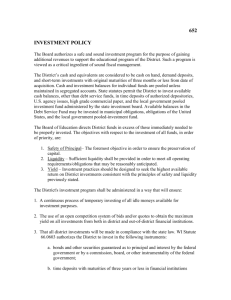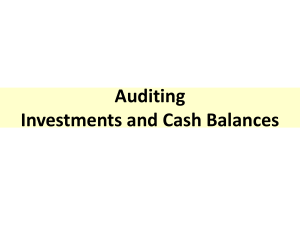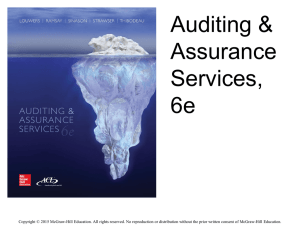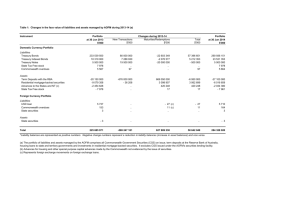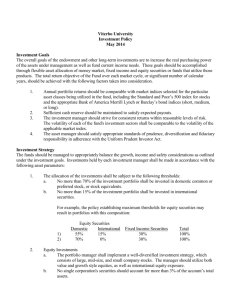Slide 1
advertisement
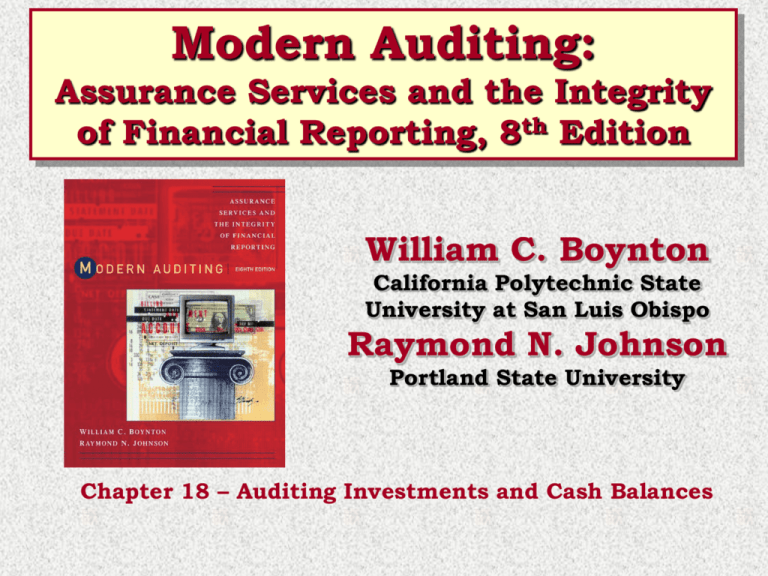
Modern Auditing: Assurance Services and the Integrity of Financial Reporting, 8th Edition William C. Boynton California Polytechnic State University at San Luis Obispo Raymond N. Johnson Portland State University Chapter 18 – Auditing Investments and Cash Balances Chapter Overview Auditing Investments Investments – Audit Objectives Investments • Understanding the Entity and Environment • Analytical Procedures • Inherent Risk Consideration of Internal Controls – Common Documents and Records • Stock certificate • Bond certificate • Bond indenture • Broker’s advice Consideration of Internal Controls – Common Documents and Records • Broker’s statement • Books of original entry • Investment subsidiary ledger Functions and Related Controls • Authorize Investment Transactions – Purchasing securities – Selling securities • Receive or Deliver Securities – – – – Receiving securities Safeguarding securities Delivering securities Receiving periodic income Functions and Related Controls • Record Transactions – Recording purchases, sales, and income – Recording market adjustments and reclassifications – Reviewing purchases, sales, and income transactions • Settle Transactions – Receiving cash – Disbursing cash – Assessing investment performance and reporting Preliminary Audit Strategies for Investments Substantive Tests of Investments • Initial Procedures • Analytical Procedures • Tests of Details of Transactions Substantive Tests of Investments • Tests of Details of Balances – Inspect and Count Securities on Hand – Confirm Securities Held by Others – Recalculate Investment Revenue Earned • Tests of Details of Accounting Estimates – Proper Classification of Investments Substantive Tests of Investments • Auditing the Fair Value of Investments • Tests of Details of Presentation and Disclosure Study Break 1. This document is an engraved, prenumbered form showing the number of bonds owned by a bondholder. A. B. C. D. Stock certificate Bond certificate Bond indenture Broker’s advice B. Bond certificate Study Break 2. While recording investing transactions, all of the following functions need to be carried out, except: A. Recording purchases, sales, and income B. Recording market adjustments and reclassifications C. Reviewing purchases, sales, and income transactions D. Assessing investment performance and reporting D. Assessing investment performance and reporting Study Break 3. All of the following are proper classification for investments, except: A. B. C. D. Held-to-maturity securities Daily securities Trading securities Available-for-sale securities B. Daily securities Auditing Cash Balances Cash Balances – Audit Objectives Cash Balances • Analytical Procedures • Inherent Risk • Consideration of Internal Controls Preliminary Audit Strategies for Cash Balances Substantive Tests for Cash Balances • Initial Procedures • Analytical Procedures Substantive Tests for Cash Balances • Tests of Details of Transactions – Perform Cash Cutoff Tests • Cash Receipts • Cash Disbursements – Trace Bank Transfers • Kiting • Bank Transfer Schedule Substantive Tests for Cash Balances • Tests of Details of Transactions – Count Cash on Hand • Cash Counts – Tests to Detect Lapping • Confirm Accounts Receivable • Make a Surprise Cash Count • Compare Details of Cash Receipts Journal Entries with the Details of Corresponding Daily Deposit Slips Substantive Tests for Cash Balances • Tests of Details of Balances – Confirm Bank Deposit and Loan Balances – Confirm Other Arrangements with Banks – Scan, Review, or Prepare Bank Reconciliations – Obtain and Use Bank Cutoff Statements • Tests of Details of Presentation and Disclosure Study Break 4. Cash is related to all of the following cycles, except: A. B. C. D. Revenue Cycle Financing Cycle Expenditure Cycle All of the Above D. All of the Above Study Break 5. This test of details of transactions for cash balances involves the counting of all undeposited cash receipts and change funds. A. B. C. D. Perform Cash Cutoff Tests Trace Bank Transfers Count Cash on Hand Tests to Detect Lapping C. Count Cash on Hand Study Break 6. ______ is a form of fraud the results in the deliberate misappropriation of cash receipts. A. B. C. D. Kiting Cash Counts Compensating Balance Lapping D. Lapping
